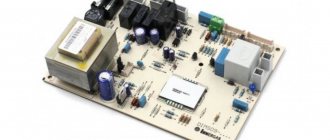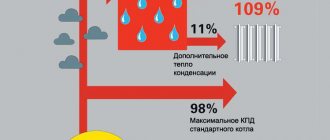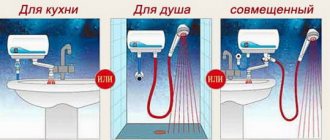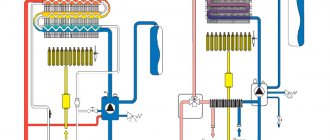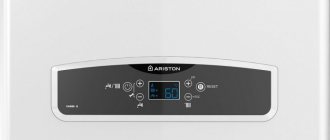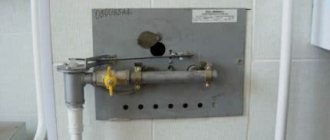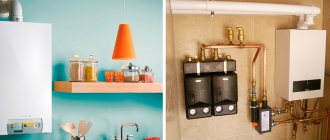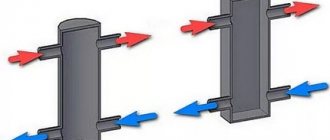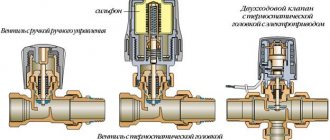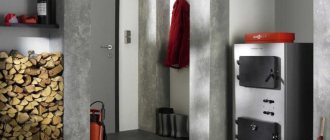Home / Gas boilers
Back
Published: 01/15/2020
Reading time: 4 min
0
2859
A gas boiler is a heat source for heating systems. This device is designed to convert the energy obtained from gas combustion into heat to heat the water coolant of the heating system.
The design of a gas boiler ensures the implementation of the main task - the efficiency and reliability of autonomous heat supply systems, with minimal participation from the user.
- 1 How gas boilers work 1.1 Double-circuit boiler
- 1.2 Gas burner design for the boiler
- 2.1 How a condensing boiler works
How gas boilers work
Main components of a gas boiler
The schematic diagram of a gas heating boiler is almost identical for most modifications. This means that the main blocks from which the boilers are assembled and the operating principle of a gas heating boiler are the same:
- The gas burner device is made in the form of a perforated rectangular structure. Inside which the nozzle is located. Gas fuel is supplied through it for combustion in the combustion chamber. Combustion efficiency is ensured by uniform distribution of fuel over the entire combustion surface.
- The heat exchanger is a steel box with a developed tubular heating surface. When gas burns, the heat released heats the walls of the heat exchanger, along the internal circuit of which the heating coolant flows. From contact with hot surfaces, the boiler heats the water, which later gives off its heat in the heating system. Single-circuit boilers have one heat exchanger for the heating circuit. In a dual-circuit system there are two, including a DHW heat exchanger.
- The circulation pump serves to force the movement of heating water in the heating circuit. The device is present only in boiler models with forced circulation.
- The expansion tank is a protective device that discharges excess coolant that is formed during heating of the heating circuit.
- Chimneys and components. Requirements for chimneys for gas boilers are determined by SNIP rules. In open-type atmospheric boilers, they are connected to chimneys operating with natural draft.
In closed fireboxes, the smoke exhaust is carried out through a coaxial pipe. Flue gases move through the central part of the pipe, and along the ring-shaped section, with the help of forced ventilation, air from the atmosphere is pumped into the firebox.
The presence of auxiliary components in the boiler distinguishes it from a gas water heater. The design of a floor-standing gas boiler differs from a wall-mounted one, with more powerful dimensions and weight, due to the fact that their design usually includes a storage tank for hot water.
The automatic control and protection unit is designed to regulate boiler modes depending on the internal/external air temperature and unit protection in case of emergency situations.
For example, high gas or coolant pressure, separation of a gas torch, water leakage, high temperature of the heating circuit or hot water supply. Its operation is based on the use of primary sensors - a gas boiler thermocouple and the operation of a three-way valve.
Double-circuit boiler
A double-circuit gas unit differs from a single-circuit boiler in that its design contains not one heat exchanger for heating, but two - primary and secondary.
Operating principle of a double-circuit boiler
The first is located directly in the gas combustion zone. Its purpose is to heat the heating fluid. The secondary one does the job of heating hot water.
It must be noted that a double-circuit gas boiler cannot operate synchronously in 2 modes. This explains the presence in its system of a three-way valve, which, when the hot water tap on the mixer is opened, sends the coolant into the DHW circuit.
Gas burner device for a boiler
The burner device of a gas boiler unit is classified into the following types:
- Single-level, capable of operating only in two options - Stop/Start. Despite their low profitability and reduced service life, they are popular due to their simple design and low price.
- Two-level, ensures the boiler operates in two modes - 50/100%. Its advantages are felt during the transitional heating period, since there is no need to use the device at full power to heat the home.
- Modulated - a smart system for adjusting the boiler unit modes, which is capable of independently adjusting the operation in the range of 20-100%. This system ensures efficient and long-lasting operation of the boiler. Moreover, its price is an order of magnitude higher than conventional heating analogues with one and two-level burner devices.
In addition, burners are divided into open and closed type installations. In the first option, the air needed for the gas combustion process comes directly from the room in which the boiler unit is located. Air for a closed firebox is supplied through a coaxial chimney using a fan to draw it from the atmosphere.
Thermal control devices
To automatically regulate the operation of the boiler, many built-in devices are used.
A thermostat or programmer is responsible for regulating the temperature.
In simpler boiler models, the temperature is regulated by a thermoelement - a special device, which is a metal structure that can change size (shrink or increase) under the influence of temperature. When heating/cooling, the thermoelement changes size, acting on a lever located next to it that closes or slightly opens the draft damper. The volume of air entering the combustion chamber, in turn, depends on the thrust force, controlling the combustion process. Advanced models are equipped with controllers that regulate air flow using a built-in fan. Thus, a thermostat can be a fairly simple or complex, and even programmable, device. Programmable thermostats - programmers - can control the implementation of specified settings for an entire week, taking into account the required temperature down to the minute.
Proper use of thermostat settings allows you to achieve savings on energy consumption of 20-30%, which will significantly reduce heating costs. Having reconsidered the need to purchase this device, you can buy a programmer for a gas boiler, even if you already have a boiler.
Programmers are devices that provide automatic temperature control. These devices can save energy consumption, provide the required indoor climate control and extend the life of heating equipment. You can regulate the water temperature in the heating system and the air temperature in the room. Standard water temperature control provides for manual or automatic switching on/off of the heating mechanism depending on the required water temperature in the radiator.
If it gets cooler or warmer outside, a different water temperature in the pipes is required and more and more adjustments have to be made. Such systems can be equipped with an electronic display and automatic adjustment. But the principle of their operation is to constantly bring the system into a mode in which the desired water temperature is achieved by turning the boiler on/off every few minutes. In this mode of constant readiness to turn on the burner, the pump runs constantly. This wears out the equipment.
A more justified option is a programmer that controls the temperature of the air in the room, rather than the water in the pipes, when the desired comfortable temperature is set and the boiler is controlled, also turning it on and off, while starting and turning off the pump only when the air temperature change sensor is triggered. The air cools and heats up more slowly, so starts occur less frequently, which minimizes energy costs and reduces equipment wear. Those who want to get more significant savings and a comfortable temperature buy a room programmer for a gas boiler; they are widely represented on the market.
Principle of operation
The operating principle of a gas heating boiler is quite simple. Through the return pipeline from the heating network inside the house, cooled water is supplied by a circulation pump to the input of the heating circuit heat exchanger.
At low coolant temperatures, an electromechanical valve opens, supplying fuel to the injector. The igniter ignites the gas and the combustion process begins. The boiler constantly operates on the heating circuit.
The DHW circuit begins to function when the tap on the mixer is opened. This thermal scheme of the boiler operation in the summer makes it similar to the operation of a conventional gas water heater.
How does a condensing boiler work?
The name “condensing” boiler units was acquired due to the fact that they implement a technology for obtaining additional thermal energy by modifying the aggregate state of condensate from steam located in the flue gases.
Operating principle of a condensing boiler
During the combustion of natural gas in a condensing gas boiler, water vapor is created, which in traditional units evaporates and is released into the atmosphere through a chimney.
Experts have developed an additional device in the boiler - a water economizer, in which steam in the flue gases turns into condensate, while releasing additional heat, which is transferred to the coolant in the economizer.
The temperature at which the condensate is converted is called the dew point of +55 C, and the technological process is called condensation. This temperature corresponds to the parameters of the return network water entering the boiler from the heating system. If it is more than +60 C, then the condensing boiler will work like a traditional device with low efficiency.
In addition, condensate creates a very aggressive environment containing acids. Therefore, its collection and disposal will require a special neutralization system, which the liquid must undergo before it can be discharged into the city sewer.
Condensing boiler. Photo source: allbuildingtips.com
In general, a convection gas boiler is an expensive device, however, fuel savings of up to 20% allow it to pay for itself within five years.
The principle of operation of a double-circuit gas boiler
The operating principle of a double-circuit boiler unit is designed for 2 thermal modes:
- heating;
- DHW.
In heating mode, the operation of the boiler is practically no different from a single-boiler boiler. Starting the burner involves a fairly long start-up period in order to increase the temperature in the heating circuit to operating levels. When the main mode is reached, the flow of fuel to the burner stops.
The internal air temperature sensor allows you to automatically regulate the temperature and sends a signal to open the gas when the permissible level decreases.
Modern double-circuit Baksi boilers, in addition to an internal temperature sensor, are equipped with a special weather-dependent automatic system that regulates the operation of the boiler based on the outside air temperature outside the building window. The burner increases the temperature of the heating water, the circulation of which through the pipelines of the heating system is ensured by a circulation pump. A three-way valve built into the system switches the movement of coolant through the heating circuit or into the DHW system.
Today's double-circuit heating boilers are equipped with automatic control and safety systems. In emergency situations, flame and draft sensors are capable of shutting off the gas supply to the boiler through an electromagnetic valve, thereby preventing the creation of an increased concentration of gas in the boiler room.
This mechanism not only shuts off the gas supply, but also informs others about the danger using sound and light alarms, and also starts exhaust ventilation to reduce the content of methane and carbon monoxide in the air.
How do wall units work?
For small houses, wall-mounted gas boilers are quite suitable. Their operating principle is approximately the same, but smaller parts and additional elements are used in the form of a circulation pump and a membrane tank. They differ from conventional analogues in their compact size.
As with floor-standing structures, wall-mounted gas boilers can be single-circuit or double-circuit. They can be equipped with a closed or open combustion chamber. The devices are fixed to the wall using special brackets.
The operating principle of a wall-mounted gas boiler is based on the presence of a complex automation system, which is considered the most capricious unit in terms of maintenance. It often fails during operation of the device. It is problematic to repair it with your own hands, so you have to call a specialist, which leads to additional costs.
Operating rules
During operation of an open-type gas boiler, it is necessary to ensure a sufficient air supply in order to ensure complete combustion of gas.
Otherwise, the efficiency of the unit will be low, and the volume of unburned gas will be large, with possible release into the room. In closed fireboxes, it is also important to monitor the sufficiency of air and the functionality of the blower fan.
Basic rules for the safe operation of a heating boiler operating on gas fuel if there is a gas smell:
- immediately turn off the gas valve to the burner device;
- open windows for ventilation;
- in closed-type boilers, forced ventilation is turned on in the chimney system of the gas boiler;
- do not use electrical switches and matches;
- immediately turn off the open flame;
- report an emergency to the gas service.
Autonomous heating is gaining popularity; for many homeowners it has become as necessary in the cold season as an air conditioning system in the summer - an affordable level of comfort in residential premises that ensures normal life activities.
The main function in this is performed by modern boiler installations - technologically advanced, innovative units capable of solving multi-level thermal problems.
